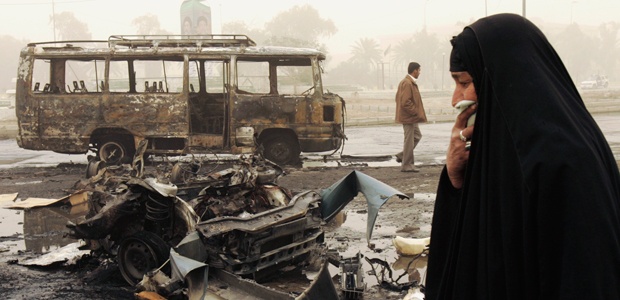Civilians Killed & Displaced

A woman walks past the scene of a bomb attack in Baghdad Jan. 29, 2007. A bomb in a small bus killed one civilian and wounded five others, police said. (REUTERS/Ceerwan Aziz)
People in war zones are killed in their homes, in markets, and on roadways, by bombs, bullets, fire, improvised explosive devices (IEDs), and drones. Civilians die at checkpoints, as they are run off the road by military vehicles, when they step on mines or cluster bombs as they collect wood or tend to their fields, and when they are kidnapped and executed for purposes of revenge or intimidation.
Many times more people die from reverberating effects including wars’ destruction of economies, leading to loss of livelihoods and food insecurity; the destruction of public services and health infrastructure; environmental contamination; and reverberating trauma and interpersonal violence. All of these effects lead to increased malnutrition, illness, injury, maternal and newborn complications, and what health experts call “indirect death.” Women and children in particular suffer the brunt of these ongoing impacts.
The insecurity that refugees and internally displaced people (IDPs) face extends far beyond the guns and blasts of war. It includes lack of access to food, health care, housing, employment, and clean water and sanitation, as well as loss of community and homes. IDPs, usually poorer migrants who lack the finances to travel abroad, often face grossly inadequate living conditions and experience high rates of malnutrition and mental health challenges; their lack of access to healthcare has particularly serious consequences for maternal, infant, and child mortality. Forced displacement, especially within nations, is strongly correlated with negative population-level health impacts and higher rates of indirect death.
Refugees abroad face many difficulties including fear of deportation, anxiety about the future, difficulty in renewing visas, and the denial of civil rights and services.
Since the 2000s, national governments and militant groups have curtailed reporting about war through myriad means, including by killing journalists, turning conflict zones like Syria and Gaza into “news graveyards.”
Key Findings
U.S.-Supported Israeli Military Operations
- In Israel, Gaza, and the West Bank since October 2023, Israeli military operations are causing widespread hunger, forced displacement and the destruction of hospitals, leading to far higher numbers of deaths than direct war violence.
- In October 2024, 96 percent of Gaza’s population (2.15 million people) faced acute levels of food insecurity. According to an October 2, 2024 letter to President Biden from a group of U.S. physicians, 62,413 people in Gaza had died of starvation.
U.S. Post-9/11 Wars
- The post-9/11 wars in Afghanistan, Pakistan, Iraq, Syria, Yemen, the most violent conflicts in which the U.S. government has engaged in the name of counterterrorism since September 11, 2001, have taken a tremendous human toll. Indirect deaths are estimated to be 3.6-3.8 million, bringing the total death toll, including direct and indirect deaths, to 4.5-4.7 million and counting. Precise mortality figures remain unknown.
- At least 408,749 civilians in Afghanistan, Pakistan, Iraq, Syria, and Yemen died as a direct result of the post-9/11 wars. U.S. drone strikes and other military operations in Somalia, Libya, and elsewhere have also caused civilian deaths.
- As of May 2023, more than 7.6 million children under five in post-9/11 war zones suffered from acute malnutrition.
Displaced People
- Over the course of the post-9/11 wars, over 38 million people in from Afghanistan, Iraq, Pakistan, Yemen, Somalia, the Philippines, Libya, and Syria were displaced, either abroad or within their own countries.
- Being internally displaced by war is associated with higher rates of indirect deaths.
- As of August 2021, since the start of the post-9/11 wars, at least 5.9 million Afghans had fled the country or been internally displaced.
- As of March 2023, more than 1.1 million Iraqis remained displaced.
- Some who managed to escape the wars in Afghanistan and Iraq fled to nearby states including Pakistan, Jordan, Syria, Lebanon, Egypt, Turkey, and Iran.
Afghanistan
- In 2023, over a million Afghans were forcibly returned from Pakistan and Iran. The Afghan government and international governing bodies and donors must support Afghans’ freedom of movement, for their mobility across borders is one solution for their need for safety.
- Comparing before the U.S. invasion (pre-2001) to after the war (2022), the percentage of Afghans facing food insecurity and living in poverty, as well as children experiencing acute malnutrition, all significantly increased.
- CIA armed Afghan militia groups commit human rights abuses and extrajudicial killings of civilians.
- Unexploded ordnance from the post-9/11 war and landmines from previous wars kill, injure, and maim civilians. Fields, roads, and school buildings are contaminated by ordnance, which often harms children as they go about chores like gathering wood.
Iraq
- The U.S. invasion and occupation of Iraq beginning in 2003, and later military operations against the Islamic State in Iraq and Syria beginning in 2014, compounded the negative health impacts of decades of harmful U.S. policy actions towards Iraq since the 1960s, including economic sanctions in the 1990s that were devastating for Iraqis.
- Studies have shown the long-lasting environmental costs of war in Fallujah, where the population has seen a 17-fold increase in birth anomalies, a rise in cancers, and myriad other health problems linked with bombardments and accompanying exposure to heavy metals. Bone sampling research detected uranium in 29% of study participants and lead in 100% of participants’ bone samples.
- War has intensified gender-based violence suffered by Iraqi women, including domestic violence, verbal and physical intimidation, sexual harassment, rape, forced marriage, trafficking, forced prostitution, female genital mutilation, and honor-based crimes, including killings.
Journalists
-
Threats to journalists in conflict zones are increasing. In 2023, a journalist or media worker was, on average, killed or murdered every four days. In 2024, it was once every three days. Most reporters harmed or killed are local journalists.
(Page updated as of June 2025)

